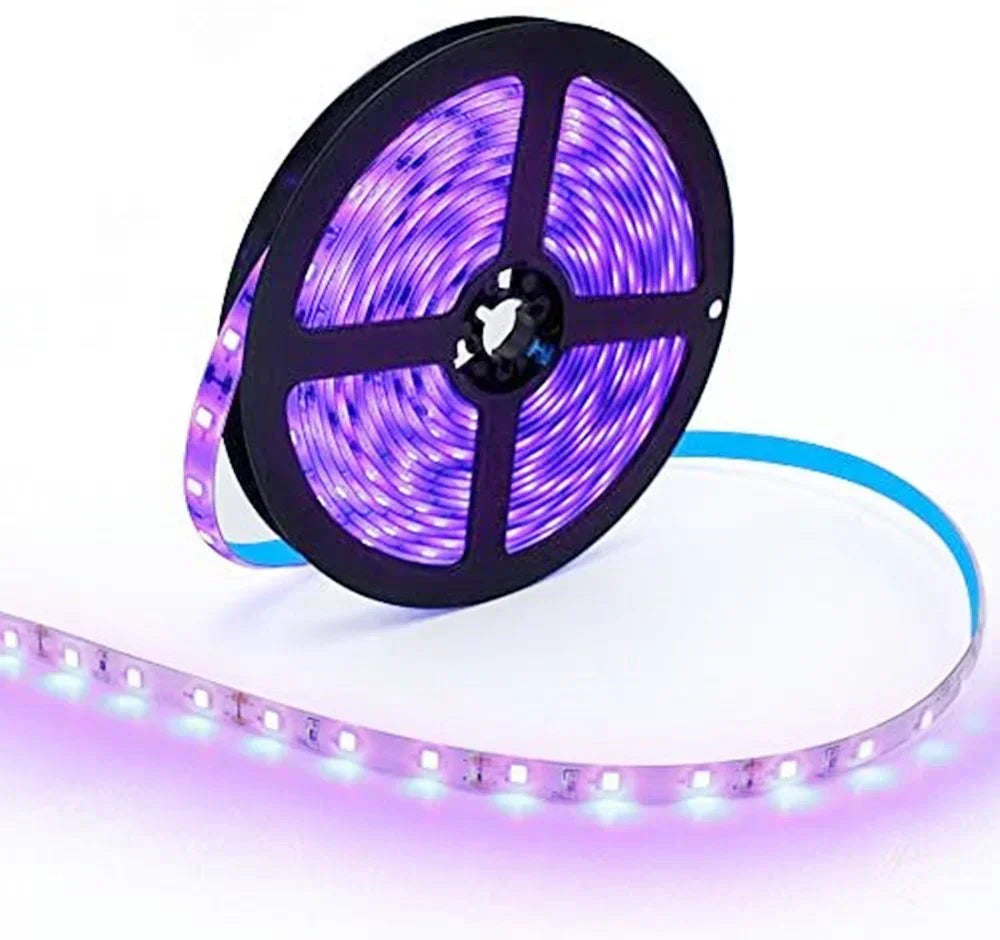In recent years, UV LED strip lights have become increasingly popular across various professional and creative fields — from resin curing and fluorescent inspections to artistic decorations and stage lighting. Their ability to emit ultraviolet radiation in precise wavelengths makes them a powerful tool for both industrial and aesthetic applications. However, the performance of a UV LED strip depends on several crucial factors: wavelength, light intensity, and material compatibility. This article will explore each of these aspects in depth to help you better understand how to select and use UV LED strips for optimal results.
1. Wavelength: The Foundation of UV Performance
The wavelength of a UV LED strip determines the type and strength of ultraviolet radiation it emits. Typically, UV LEDs are categorized into three main types:
-
UVA (315–400nm) – Most commonly used in LED strips. Ideal for curing, fluorescence activation, and inspection lighting.
-
UVB (280–315nm) – Used in medical and biological applications, such as phototherapy and sterilization.
-
UVC (100–280nm) – Highly germicidal but less commonly used in flexible strips due to its material degradation risks and safety concerns.
For general use, UVA wavelengths around 365–405nm are most popular.
-
365nm–370nm LEDs produce near-invisible light ideal for curing and fluorescence excitation.
-
380nm–385nm is a versatile range for currency verification and medical equipment.
-
395nm–405nm provides a stronger visual glow effect, perfect for blacklight parties, stage lighting, and decorations.
Selecting the correct wavelength ensures not only better results but also prevents material damage or ineffective curing.
2. Intensity: Balancing Efficiency and Application Needs
The light intensity of UV LED strips directly affects how deeply and evenly UV radiation penetrates surfaces. It depends on several factors: LED density (e.g., 60, 120, or 240 LEDs/m), chip efficiency, and power input (e.g., 12V or 24V systems).
-
Higher LED density (120–240 LEDs/m) delivers more uniform illumination, ideal for professional curing and inspection environments.
-
Lower density (60 LEDs/m) versions are suitable for decorative or low-intensity applications, such as parties or ambient lighting.
However, intensity also impacts heat generation and longevity. Continuous operation at full brightness without proper cooling can reduce the lifespan of UV diodes. Therefore, users should consider aluminum channels or heat-dissipating surfaces when installing high-density UV LED strips for prolonged use.
3. Material Compatibility: Ensuring Safe and Stable Use
Unlike visible light, UV radiation can cause chemical reactions or degradation in certain materials. For example:
-
Some plastics and resins may yellow or crack after long-term UV exposure.
-
Adhesives and coatings must be UV-resistant to prevent peeling or discoloration.
-
Protective layers such as IP67 waterproof coatings can help reduce UV damage while ensuring outdoor durability.
When selecting UV LED strips, it’s essential to ensure that both the strip housing and surrounding materials (like adhesives, diffusers, or enclosures) are designed to withstand UV exposure.
4. Practical Applications of UV LED Strips
Depending on their wavelength and intensity, UV LED strips serve a wide range of purposes:
-
Curing and printing: Ideal for resin, glue, and ink solidification.
-
Fluorescent inspection: Used for detecting leaks, cracks, or counterfeit currency.
-
Entertainment and decoration: Creates dramatic effects for blacklight parties, body painting, and Halloween displays.
-
Scientific and medical fields: Supports sterilization, phototherapy, and laboratory analysis.
By aligning wavelength and intensity with your specific application, you can achieve maximum performance and reliability.
5. Recommended UV LED Strip Products
Below are some high-performance UV LED strip solutions from LEDLightsWorld, suitable for different wavelengths and applications:
| Product | Description | Link |
|---|---|---|
| 395–405nm SMD2835 UV LED Strip Light | Perfect for parties, curing, and fluorescent effects. Available in non-waterproof and IP67 versions. | View Product |
| 380–385nm SMD2835 UV LED Strip Light | Suitable for curing, medical use, and currency validation. | View Product |
| 365–370nm SMD2835 UV LED Strip Light | High precision curing and fluorescence excitation applications. | View Product |
| USB-Powered 380–400nm UV Light Strip (2-Pack) | Portable UV light strip for glow decorations and parties. | View Product |
| 36W 385–400nm UV Black Light Bar | Powerful bar light for large-area illumination, perfect for events or stage lighting. | View Product |
6. Conclusion
The performance of UV LED strips depends on understanding the interplay between wavelength, intensity, and material compatibility. By choosing the right combination, you can ensure maximum efficiency, safety, and durability for your intended use. Whether you are an engineer working on precision curing or an artist creating immersive blacklight experiences, LEDLightsWorld offers a complete range of UV lighting solutions to help you achieve exceptional results.

